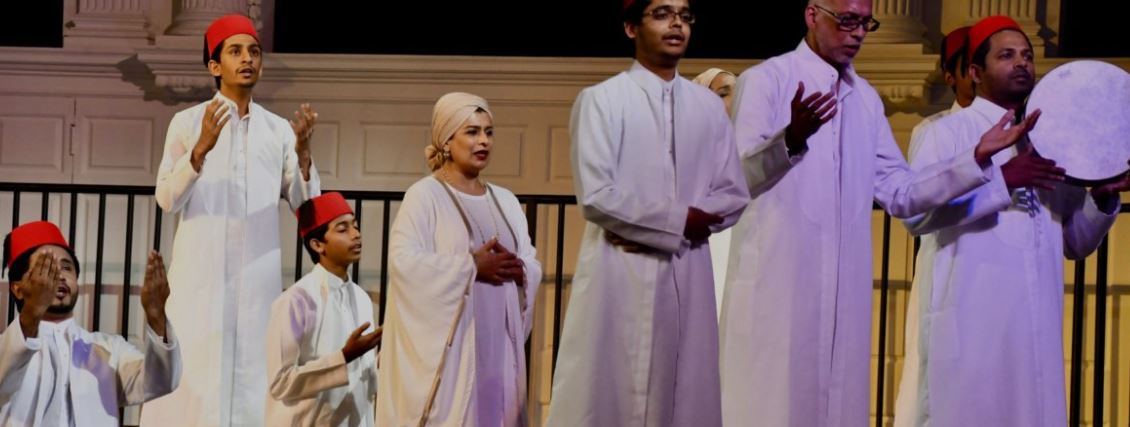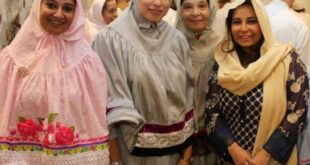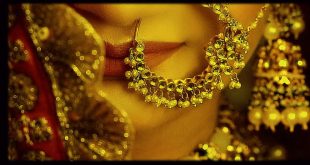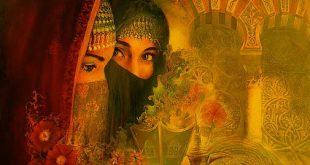In a brilliant and much needed documentary directed by Nadya Perera, one of the fast dying heritages of Sri Lankan Muslims, namely their musical traditions, has been brought to light. The Muslim community and particularly its younger generation is in debt to this Sinhala director for what she has painstakingly accomplished in bringing back memories from a dying generation of Muslim musicians, singers and performers – a treasure trove that needs to be preserved, modernized and enriched.
directed by Nadya Perera, one of the fast dying heritages of Sri Lankan Muslims, namely their musical traditions, has been brought to light. The Muslim community and particularly its younger generation is in debt to this Sinhala director for what she has painstakingly accomplished in bringing back memories from a dying generation of Muslim musicians, singers and performers – a treasure trove that needs to be preserved, modernized and enriched.
Historically there is a very close and cordial relationship between Muslims and music. In fact, the Arabic Quran itself is a fountain of music. Outside the Quran, there is music is inseparable from every religious ritual and celebration in Islam. Yunus al Katib, a Muslim musicologist in the 8th century, wrote the first book in Arabic on the theory of music and compiled the first collection of songs. During the medieval era Baghdad, Cordoba, Delhi, Isfahan and Istanbul successively outshone the rest of the world not simply as capitals of Muslim imperial might, wealth and affluence but also as powerhouses of arts and culture.
Music in particular dominated Muslim cultural life from patricians to plebians. Even in modern times, who would forget the voice of that Egyptian nightingale Umm Kulthum who mesmerized the Arab world with her lyrics or Pakistan’s Nusrat Fateh Ali Khan whose Qawwalis captured the hearts of Western pop singers? Ghazal and Qawwali, two of the most popular rhythms of vocalists, have invaded modern cinema also. How many Sri Lankans would know that the famous Sinhala song sung by the late Mohideen Beg, Buddang Saranang Gachchame, was of Qawwali origin? Regrettably, this rich history and contribution of Muslims to music has received a setback with the rise of Islamic orthodoxy.
The Muslim community in Sri Lanka is famed for its business acumen and religious devotion; the shop, mosque and home are the three magnets that pull the daily attention of Muslims. Material needs dominate their way of life. Even the religion of Islam has received a materialist twist in the preaching of mullahs. There is only a little space in Muslim life for appreciation of cultural aesthetics. But it was not so in the past. There were plenty of occasions in which Muslim men and women proudly participated and indulged in musical entertainment. Kalikkambu (joyous baton), oonjal paattu (swing song), naattukkavi (rural lyrics), faqir byth (mendicants melodies) and several other forms of secular and cultural entertainment were produced and performed in open spaces and on public platforms, and were watched by throngs of men and women, especially during moonlight nights. Ms. Perera has captured a number of them in her documentary. These traditions were kept alive until the advent of the Tabligh Jamaat in the fifties followed by the influx of Wahhabi purists after 1970s. To these purifiers of religion music, unless it carried an Islamic flavour and content, meant the devil’s instrument lead the pious astray. When the former Minister of Education Badiuddin Mahmud tried to introduce music and fine arts in Muslim schools’ curricula, there was widespread protest from mullahs and Muslim politicians.
In the past, oonjal paattu, kalikkampu, rabban and other folk entertainment were encouraged and performed by both men and women and sometime in competition. Music dominated even their mundane activities such as ploughing, weeding and harvesting in paddy fields. Fisherfolks had their own songs and rhythms when pulling heavily loaded fish nets ashore. Muslim women in the east who had never done any formal schooling had a special talent to compose and sing kavis in Tamil on varied themes including love, romance and even sex. These kavis had their own tune and rhythm. When Muslim tenants from Pottuvil, Akkaraipattu, Sammanthurai, Kalmunai and other places carried the harvested crop to their absentee landlord, who lived miles away in places like Kattankudy, they traveled in chains of bullock carts and usually at nights. To keep awake they too composed and sang kavis. Hundreds of those kavis were collected and published later in a book by Professor S. Vithiananthan in 1960s.
With the neglect of this golden tradition, the oppressive influence of ultrareligious orthodoxy and the invasion of Tamil and Hindi cinema, Muslim music took a different turn. The Radio Ceylon Tamil service became the chief vehicle through which this music prospered. The so-called Islamic songs sung by local artists over the radio were bereft of any originality. They were simply the reproduction of Tamil and Hindi cinema tunes with an Islamic touch. There are no music composers among Muslims because orthodoxy discouraged such professions. Ms. Perera’s interviewees had touched on this issue. In general, music and fine arts has been shunned by the religious hierarchy and as a result there are few professional Muslim music groups today in a community of two million. Music is not a subject preferred by Muslim schools. Muslim girls in particular are prevented from pursuing music as a profession because patriarchy believes that it would be difficult to find a husband for such girls. That fear was expressed in Ms. Perera’s documentary. What a petty and fallacious argument in defence of male chauvinism. To prevent talents gifted to children by the Creator is against the essence and spirit of the Quran.
Suppressing musical productions and performances is a tragedy and one of the causes that contributes to the social isolation of Muslims in a multi ethnic and multi cultural society. Sports and music are two aspects of life that attract the young and create friendship. As the American Jazz composer Roy Ayers said, “The true beauty of music is that it connects people.” Music not only connects people but also enriches the stock of shared cultural capital in a multi ethnic polity like Sri Lanka. Just imagine for a moment the positive impact that kalikkambu or faqir byth would have in promoting inter communal togetherness if a group of young Muslims in their traditional attire could perform those musical extravaganzas as part of the Esala Perahera procession, which annually attracts a crowd of thousands of men, women and children of all faiths including foreigners. What do Muslims lose by participating in this cultural pageant?
The lost musical traditions of Muslims need a rebirth and Ms. Perera’s historic documentary should be an eyeopener to the community. Professor Sarachchandra Ediriweera modernized Sinhala folk drama and made it a living art of Sinhala Buddhist culture and Professor Vithiananthan did the same for Tamil Kooththu. Will any Muslim don in any of the universities give life to the dying musical traditions of Sri Lankan Muslims and become the focal point of a cultural renaissance in this community?
A post shared by Groundviews (@groundviews)
source : https://groundviews.org/2023/04/20/disappearing-music-traditions-of-muslims/
Post Disclaimer | Support Us
Support Us
The sailanmuslim.com web site entirely supported by individual donors and well wishers. If you regularly visit this site and wish to show your appreciation, or if you wish to see further development of sailanmuslim.com, please donate us
IMPORTANT : All content hosted on sailanmuslim.com is solely for non-commercial purposes and with the permission of original copyright holders. Any other use of the hosted content, such as for financial gain, requires express approval from the copyright owners.
 Sri lanka Muslims Web Portal Sri Lanka Muslims News Center
Sri lanka Muslims Web Portal Sri Lanka Muslims News Center
 Donate
Donate


